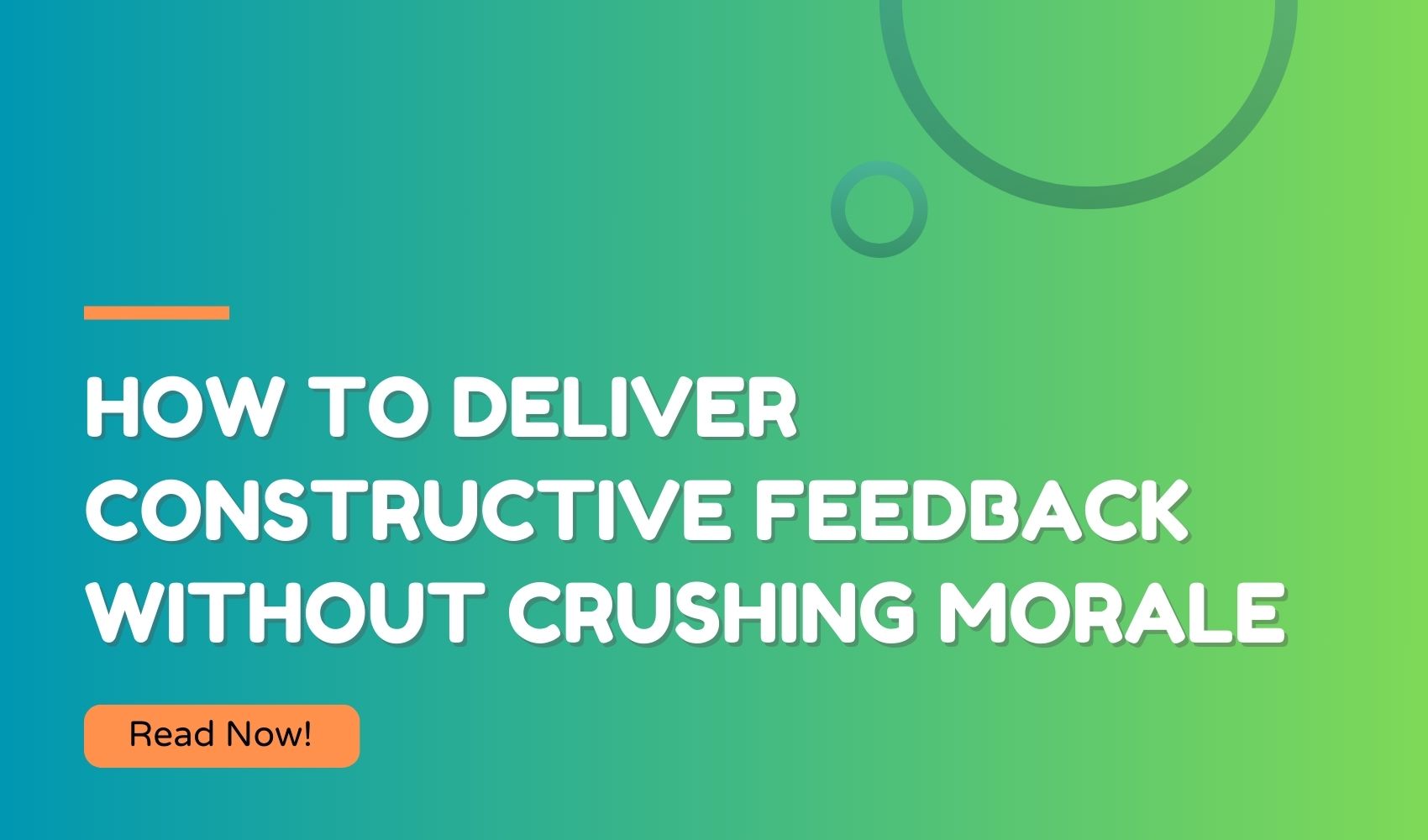How to Deliver Constructive Feedback Without Crushing Morale

Feedback shapes growth, strengthens teams, and improves performance. Delivered well, it becomes a tool for motivation and improvement. Delivered poorly, it leads to defensiveness, frustration, or disengagement.
Constructive feedback highlights areas for development while maintaining confidence. Harsh words or vague criticism accomplish little beyond discouragement. Striking the right balance creates an environment where people feel valued and motivated to improve.
Prepare Before Giving Feedback
A rushed or unplanned approach often backfires. Thoughtful preparation sets the stage for a productive conversation.
Clarify the Purpose – Every piece of feedback should serve a goal. Whether it involves refining a skill, improving communication, or adjusting behavior, defining the purpose beforehand keeps the message clear.
Choose the Right Moment – Timing influences how feedback is received. Bringing up concerns in the middle of a stressful deadline or public setting increases resistance. A private, calm environment fosters better discussion.
Consider the Other Person’s Perspective – People interpret words through their own experiences, emotions, and stress levels. Anticipating possible reactions makes it easier to frame messages in a way that encourages openness instead of defensiveness.
Start with a Positive Foundation
Building trust strengthens the impact of any feedback. Without it, even well-intentioned advice feels like criticism.
- Recognize Strengths First: Acknowledging positive contributions shows appreciation and makes the conversation feel balanced.
- Avoid Forced Compliments: Overly structured methods, like the “compliment sandwich,” sometimes feel insincere. If the praise doesn’t align with the overall message, it loses its value.
- Create a Safe Space for Growth: People respond better to feedback in environments where mistakes are seen as learning opportunities rather than failures. Encouraging open dialogue makes future conversations easier.
Be Clear and Specific
Vague statements lead to confusion. Without concrete examples, feedback lacks direction and leaves room for misinterpretation.
A comparison illustrates the difference:
| Vague Feedback | Clear, Actionable Feedback |
|---|---|
| “Your reports need improvement.” | “The last report had a few missing data points. Including those will strengthen the analysis.” |
| “Your presentations should be better.” | “Speaking more slowly and adding visual examples would help engage the audience.” |
Precision removes uncertainty. The clearer the message, the easier it becomes to act on it.
Use a Supportive and Neutral Tone
Delivery matters just as much as content. The same words spoken in different tones create vastly different reactions.
Watch the Language – Statements that feel accusatory, such as “You always…” or “You never…,” trigger defensiveness. A better approach focuses on observations: “I noticed that…” or “I’ve seen that…”
Choose Words Carefully – Saying “This was wrong” shuts down the conversation. “Here’s how this could be more effective” keeps the focus on progress.
Body Language and Expression – A neutral expression and steady tone prevent misinterpretation. Defensive posture crossed arms, or a raised voice sends mixed signals.
Creating an environment where feedback feels like guidance rather than criticism encourages engagement instead of resistance.
Make It a Two-Way Conversation
Feedback should never feel like a lecture. Involving the other person in the discussion improves collaboration and mutual understanding.
- Ask Open-Ended Questions: “How do you think this could be improved?” invites reflection. Instead of dictating a solution, guiding the person toward their own insights makes the feedback more meaningful.
- Listen Without Interrupting: Giving space for responses builds trust. Cutting someone off or dismissing their thoughts creates frustration.
- Acknowledge Their Perspective: Understanding the reasons behind certain actions helps tailor feedback to the situation. A one-size-fits-all approach rarely works.
Offer Solutions and Actionable Steps
Pointing out problems without suggesting improvements leaves people uncertain about what to do next. Clear steps guide progress and keep motivation intact.
Instead of saying, “This approach isn’t working,” shift to, “Here’s a way to improve the outcome.” Framing feedback around solutions turns the conversation from a critique into an opportunity for growth.
If a report lacks depth, mention resources that could help refine research. If a presentation feels unstructured, suggest a framework to improve clarity. Offering options rather than dictating fixes allows the other person to feel involved in the process.
Goal-setting strengthens feedback. Instead of broad instructions, define clear expectations. Saying, “Let’s focus on adding specific examples in the next report,” creates a measurable objective, making it easier to track progress.
Follow Up and Recognize Progress
Feedback isn’t a one-time exchange. Revisiting the conversation reinforces positive change and keeps communication open. A simple follow-up, such as “I noticed the adjustments in your latest report. It’s much clearer now,” acknowledges effort and strengthens motivation.
A progress check doesn’t need to be formal. A quick mention during a conversation, an email, or a team meeting can be enough to encourage continued improvement. Small moments of recognition carry weight, especially in a fast-paced work environment.
People often hesitate to bring up past feedback, assuming the topic is closed. Keeping the dialogue open allows adjustments along the way. Instead of waiting for a scheduled review, casual check-ins help fine-tune progress and offer ongoing support.
Giving Feedback in Difficult Situations
Some conversations require extra care. Addressing sensitive topics, dealing with resistant attitudes, or handling feedback remotely adds layers of complexity.
Approaching Sensitive Topics
Difficult feedback should never feel like an attack. Stating observations rather than making personal judgments lowers defensiveness. Instead of saying, “You’re too aggressive in meetings,” shift to, “Some team members feel hesitant to share ideas. Finding a way to create space for others could help.“
Timing matters even more in these situations. If emotions are high, it’s best to wait for a more neutral moment. Delivering feedback at the peak of frustration rarely leads to a constructive outcome.
Handling Resistance
Not everyone welcomes feedback. Some react defensively, others disengage entirely. The key is focusing on shared goals. Instead of pushing back against resistance, frame feedback in a way that highlights its benefit.
For example, instead of saying, “You need to change this approach,” try, “Adjusting this could help the team meet deadlines faster.” Aligning feedback with personal or team success encourages cooperation rather than conflict.
Providing Feedback Remotely
Virtual settings make nonverbal cues harder to read. Without tone and body language, messages risk being misinterpreted. Choosing video calls over written messages allows for better understanding. If written feedback is necessary, phrasing it with extra care prevents unnecessary tension.
When working remotely, a feedback loop becomes even more important. Following up after discussions clarifies expectations and provides reassurance that the conversation remains open.
Conclusion
A strong feedback culture lifts people up rather than tearing them down. Clarity, timing, and delivery shape how feedback is received and applied. Encouraging dialogue, offering solutions, and following up turn feedback into a tool for progress instead of a source of frustration.
Improvement happens through conversation, not correction. Making feedback a continuous exchange rather than a one-sided critique builds confidence, strengthens relationships, and leads to lasting results.



